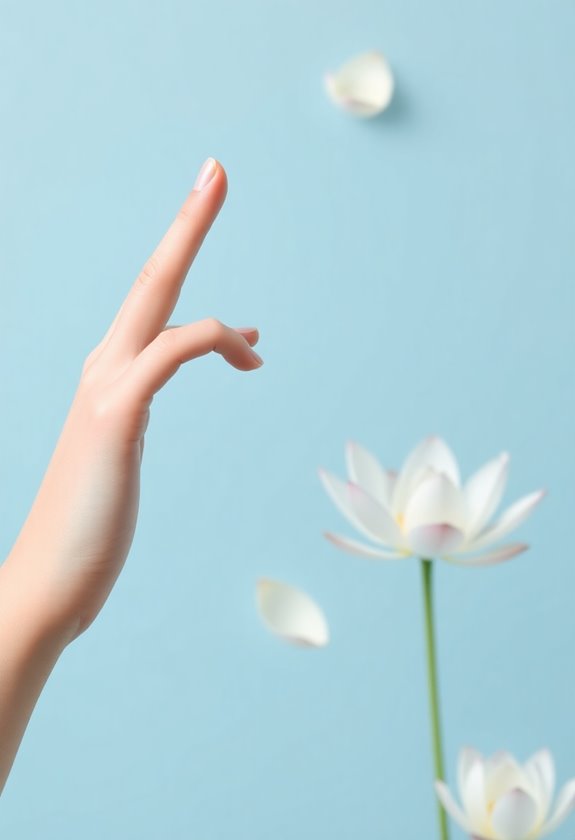You'll find several proven breathing techniques to master before your next presentation, including the focused Diaphragm Activation Method and the military-tested Box Breathing approach. The Power Pause Breath uses a simple 5-5-5-5 pattern, while the Calming Balloon Exercise combines visualization with deep breathing for anxiety relief. Alternate Nostril Breathing enhances mental clarity, and Energy Boost Breathing provides quick revitalization. The Peak Performance Sequence, Rhythmic Breathing, and Stimulating Breath Technique round out these essential practices. Understanding these techniques will transform your presentation confidence and speaking abilities.
Highlights
- Box breathing's 4-count pattern effectively calms nerves by regulating breath through equal inhale, hold, and exhale intervals.
- Diaphragmatic breathing activates your primary breathing muscle, reducing anxiety when practiced 5-15 minutes daily before presentations.
- The Power Pause Breath uses a simple 5-5-5-5 pattern to center yourself immediately before speaking.
- Alternate nostril breathing balances oxygen flow and enhances mental clarity by engaging both brain hemispheres.
- The Peak Performance Sequence uses a 4-7-8 count pattern, adaptable to 2-2-4 during actual presentations.
The Diaphragm Activation Method

The diaphragm, your body's primary breathing muscle, holds the key to mastering presentation anxiety. You'll need to learn how to activate it properly to harness its calming power before stepping onto the stage.
To begin, sit comfortably and place one hand on your chest while resting the other on your abdomen. As you breathe in through your nose, focus on pushing your belly outward while keeping your chest still, then hold this breath for two seconds. Next, exhale slowly through your mouth, letting your abdomen fall naturally. This technique lowers blood pressure and helps you stay centered. You can enhance this technique by humming during exhalation, which helps extend your breath and deepens the relaxation response. Practice this method for 5-15 minutes daily, and you'll develop a reliable tool for managing pre-presentation nerves.
Box Breathing Technique

Among the most powerful tools for presentation anxiety, box breathing stands out as a versatile technique you can master in minutes. This four-part breathing method, used by Navy SEALs and other professionals, helps you regain control when stress threatens to derail your presentation performance.
The technique can be practiced in any environment, making it perfect for those moments before stepping onto the stage.
To practice box breathing effectively, you'll want to:
- Inhale slowly through your nose for four counts, feeling your lungs and abdomen expand
- Hold that breath for four counts while maintaining your posture
- Release the air through your mouth for four counts, completely emptying your lungs
If you're new to this technique, start with two or three-second counts until you're comfortable. You can practice this technique right before your presentation, and you'll likely notice improved focus and reduced anxiety within just a few cycles.
Calming Balloon Exercise

Building on the calming effects of box breathing, you'll find the balloon exercise offers a more playful approach to managing presentation jitters. Here's how to practice it effectively:
- Sit comfortably with your knees bent and place your hands on top of your head.
- As you inhale through your nose, raise your arms slowly upward, imagining you're inflating a balloon.
- Exhale fully while lowering your arms, and pause for a count of three to enhance the calming effect.
- Engage your core muscles throughout each breath cycle, focusing on deep belly breaths.
- Repeat this coordinated breathing and movement several times until you feel centered.
You'll notice this technique helps reduce nervous system activity while improving your lung capacity, making it particularly effective before stepping onto the presentation stage. This exercise has been shown to reduce stress levels significantly when practiced regularly.
Alternate Nostril Breathing

Practiced for centuries in yogic traditions, alternate nostril breathing offers a powerful technique to calm your nerves before presenting. You'll find this method particularly effective at regulating your nervous system and reducing anxiety while improving mental clarity before stepping onto the stage.
This gentle breathing practice is safe for most individuals when performed correctly.
Here's how to perform this breathing technique:
- Sit comfortably and raise your right hand to your nose, positioning your thumb over your right nostril and ring finger over your left
- Begin by closing your right nostril with your thumb, inhaling slowly through your left nostril for four counts
- Close your left nostril with your ring finger, release your thumb, and exhale through your right nostril
This practice enhances oxygen flow, lowers blood pressure, and helps you maintain focus during your presentation by engaging both hemispheres of your brain.
Power Pause Breath

The Power Pause Breath technique offers another effective way to center yourself before presentations. You'll find this method particularly helpful for managing pre-speaking anxiety through its simple yet powerful 5-5-5-5 pattern of controlled breathing.
To practice this technique:
- Sit with your back straight or stand in a relaxed position
- Inhale slowly through your nose for 5 seconds
- Hold your breath for 5 seconds
- Exhale through your mouth for 5 seconds
- Hold again for 5 seconds before repeating
When you're consistent with this practice, you'll notice improvements in your breathing control and overall presentation confidence. The technique's regulated pattern helps release tension, enhance your focus, and promote better oxygen flow throughout your body, making it especially valuable in those critical moments before stepping onto the stage. This method combines elements of deep diaphragmatic breathing to increase oxygen intake and reduce stress levels.
The 4-7-8 Breathing Pattern

Among the most powerful breathing exercises, the 4-7-8 pattern stems from ancient yogic practices of pranayama. You'll find this technique particularly effective for calming pre-presentation nerves when you practice it consistently before stepping onto stage.
To perform this breathing pattern correctly:
- Sit comfortably with your tongue against the roof of your mouth, then inhale quietly through your nose for 4 seconds
- Hold your breath for 7 seconds while maintaining your relaxed posture
- Exhale completely through your mouth with a whooshing sound for 8 seconds
This powerful technique can reduce your anxiety levels, lower your blood pressure, and help you maintain composure during high-stakes presentations. You'll want to practice this pattern twice daily with four cycles each time, gradually increasing the frequency as you become more comfortable with the technique.
Grounding Ocean Breath

While many breathing techniques focus on counting patterns, Grounding Ocean Breath stands out for its distinctive ocean-like sound and profound calming effects. You'll find this technique particularly useful before stepping onto the stage, as it helps lower blood pressure and reduce presentation anxiety.
To practice this technique:
- Sit with a straight spine and place your hands on your knees
- Keep your mouth closed and breathe only through your nose
- Create a gentle ocean-like sound in your throat as you breathe
- Aim for 5-6 seconds on each inhale and exhale
- Fill your lungs completely, from abdomen to upper chest
You'll notice immediate benefits, including improved focus, reduced tension, and enhanced vocal quality – all essential elements for delivering a confident presentation.
Mindful Three-Part Breath

Mastering three-part breath can transform your presentation delivery by establishing a deep mind-body connection. When you're facing an audience, this ancient yoga technique helps regulate your nervous system while increasing oxygen flow throughout your body. To practice this calming breath, find a comfortable position and place your hands on your abdomen and chest.
- Inhale deeply to fill your abdomen, expanding it like a balloon
- Continue breathing to expand your rib cage outward
- Complete the inhale by lifting your upper chest and collarbone area
As you exhale, release the breath in reverse order: upper chest, ribcage, and finally abdomen. You'll want to practice this technique for five minutes daily before your presentation date, allowing the rhythmic breathing to become second nature when you're on stage.
Energy Boost Breathing

Need an instant energy boost before your presentation? You'll find bellows breath to be one of the most effective techniques for quick energy when you're feeling sluggish before taking the stage. Start by sitting with a straight spine and relaxed shoulders, then take a deep breath through your nose. Force the air out through your nose while contracting your abdominal muscles, and repeat this rapid inhale-exhale pattern for 20-30 breaths.
For sustained energy throughout your presentation, try the stimulating breath technique:
- Sit comfortably with your spine straight
- Close your eyes and inhale deeply through your nose
- Exhale slowly while making a humming sound
- Focus on the vibration and sound for 5-10 breaths
- Return to normal breathing when you feel energized
Peak Performance Breathing Sequence

Building on the energy-boosting techniques, the Peak Performance Breathing Sequence takes your presentation skills to the next level. You'll want to sit up straight with relaxed shoulders and place your hands at your lower ribs to feel the breath's movement.
Here's your sequence for peak performance:
- Begin with a 4-second inhale through your nose, hold for 7 seconds, then exhale for 8 seconds
- During your presentation, adapt to a 2-count inhale, 2-count hold, and 4-count exhale
- Practice counting silently: inhale one-two-three-four, exhale eight-seven-six-five-four-three-two-one
You’ll notice improved focus and reduced anxiety as you master this technique. When you’re practicing, spend 5-10 minutes establishing your rhythm and maintaining awareness of your breath’s sensations. Consider combining these breathing exercises with natural herbal remedies to maximize your stress relief before important presentations. Once you have established your rhythm and are comfortable with the sensations of your breath, you can begin to incorporate simple breathing techniques to further enhance your focus and reduce anxiety. One effective technique is to add a count to your inhales and exhales, such as inhaling for a count of four and exhaling for a count of six. Another helpful technique is to practice mindful breathing, where you deliberately focus on the sensations of each breath as it enters and leaves your body. These simple breathing techniques, when combined with natural herbal remedies, can provide a powerful tool for managing stress and anxiety in high-pressure situations.
Frequently Asked Questions
How Long Before Seeing Results From Regular Breathing Practice for Public Speaking?
Practice makes perfect, and you'll notice breathing exercise benefits unfold in distinct stages. You'll feel immediate effects like reduced anxiety within minutes before a presentation, while short-term improvements in voice control and delivery appear within 2-3 weeks of regular practice. For lasting confidence and enhanced public speaking skills, you'll need consistent practice over 2-3 months, making it part of your daily routine.
Can Breathing Exercises Help With Throat Tightness During Presentations?
Yes, breathing exercises can effectively reduce throat tightness during presentations. You'll find particular relief through diaphragmatic breathing, which relaxes your neck and shoulder muscles while reducing tension. When you practice techniques like pursed lip breathing and the sniff-breath method regularly, you're training your body to maintain an open, relaxed throat under pressure. These exercises work best when you start them at least 10-15 minutes before your presentation.
Should I Practice Breathing Exercises While Standing or Sitting?
Like a skilled athlete who masters both standing and seated positions, you'll benefit from practicing breathing exercises in both postures. Start with sitting exercises, as they're easier to control and help you develop proper diaphragmatic breathing techniques. Once you're comfortable, incorporate standing practice to prepare for real presentation scenarios, where you'll likely be on your feet speaking and gesturing.
What Should I Do if Deep Breathing Makes Me Dizzy?
If deep breathing makes you dizzy, slow down your breathing rate immediately and take shallower breaths until the sensation passes. You'll want to focus on diaphragmatic breathing, which means breathing into your belly rather than your chest. Try pursed-lip breathing by inhaling through your nose and exhaling slowly through slightly pursed lips, as this technique helps maintain proper CO2 levels and prevents dizziness.
Are Breathing Exercises Effective When Presenting in Virtual Meetings?
While you might think breathing exercises aren't as important in virtual meetings, they're actually vital for maintaining your composure and vocal quality on screen. You'll find that deep breathing helps steady your voice and reduces anxiety, just as it does in person. When you practice diaphragmatic breathing before and during virtual presentations, you'll notice improved vocal projection and clearer delivery, which is essential for engaging remote audiences effectively.




